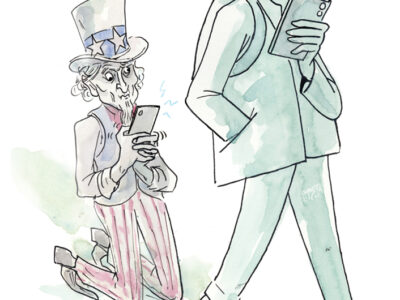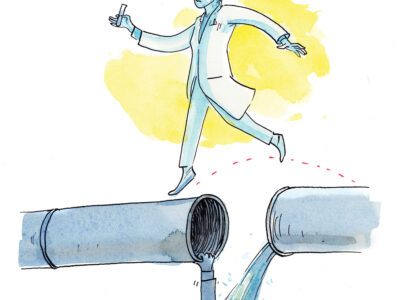
Why marriage is the wrong dividing line between relationships that count and those that don’t.
By Nancy Polikoff
Diane received a call while at work that Judith, her partner of 23 years, had suffered a heart attack and been airlifted to a hospital. She used personal leave to race to her side. The next day she returned to work, explained her situation, and requested family medical leave. Her boss refused, telling Diane the law required him to grant leave only to care for a spouse, parent, or child.
Eugene did not come home from his job on the 102nd floor of the south tower of the World Trade Center on Sept. 11, 2001. When Larry, his partner of 14 years, filed a workers’ compensation claim, the reviewing agency replied that he did not qualify for survivors benefits, which might instead be paid to Eugene’s father, from whom Eugene had been estranged for 20 years.
These stories may sound familiar. With marriage for same-sex couples frequently in the news—most recently in California, where people will vote it up or down in November—gay-rights advocates use tales like these as potent ammunition for the justness of their cause. If Larry and Eugene had been married, advocates say, Larry would have received workers comp survivors benefits. If Diane and Judith had been married, Diane would have been entitled to leave. The harm, in these tellings, is caused by the denial of marriage to same-sex couples. The solution is allowing gay and lesbian couples to marry.
But when I look at these men and women, I do not see a legal system that harms same-sex couples by denying them marriage. I see a legal system that harms unmarried couples of any sexual orientation, as well as single-parent households, extended-family units, and any other constellation of individuals whose emotional and economic ties do not conform to the one-size-fits-all marriage model.
The solution is to value all families, and the way to do it is by reforming laws that grant marriage its unique legal consequences. Where those laws serve a valuable purpose, we should endeavor to further it without creating a special status for married couples. But first, one more story.
On November 27, 1978, openly gay San Francisco Supervisor Harvey Milk was assassinated by a former supervisor, who also murdered the city’s mayor, George Moscone. Milk was a community leader dubbed “The Mayor of Castro Street,” and the first openly gay elected official in a major U.S. city. His surviving partner, Scott Smith, received workers comp death benefits. Scott Smith and Harvey Milk were not married; they were not even registered domestic partners, a status that was not yet invented and didn’t come to San Francisco until 1989. Scott was successful because California does not limit this benefit to spouses.
Had the World Trade Center been a landmark in Los Angeles, Larry could have qualified.
Likewise, if Diane had worked for the federal government, she could have used her sick leave to care for Judith. That’s because federal workers can use their sick leave to care for “any individual related by blood or affinity whose close association with the employee is the equivalent of a family relationship.” Laws like these solve the problems same-sex couples describe and meet today’s needs far better than laws carving out “special rights” for marriage.
This proposal is not a way to avoid the civil-rights claim that gay and lesbian couples deserve equality. They do. Exclusion from marriage—even when a state offers a substitute such as civil union—is a stamp of inferiority, a badge of second-class status.
But gay-rights advocates don’t rely solely on equality-based arguments; they think it politically more persuasive to parade the harms suffered by same-sex couples and argue that marriage is the way to eliminate those harms. Thus their legitimate civil-rights claim is transformed into a misguided family-policy claim, one that does not question the special rights that marriage bestows and asks only to have those rights extended to same-sex couples.
This wasn’t the foundation of the early gay-rights movement. That movement emerged at the time when feminism and the sexual revolution were transforming family life, loosening the iron-clad grip of patriarchal marriage on social organization. In that context, gay-rights advocates naturally joined a chorus of voices—including those championing divorced and never-married mothers, communal households, extended families, and other diverse family structures. In 1973, for example, the American Home Economics Association, hardly a radical fringe group, defined family as
“two or more people who share resources, share responsibility for decisions, share values and goals, and have commitments to one another over time. The family is that climate that one ‘comes home to’ and it is this network of sharing and commitments that most accurately describes the family unit, regardless of blood, legal ties, adoption or marriage.”
But that era was followed by a dramatic right-wing backlash—against abortion, against gay rights, against mothers without husbands.
The so-called “marriage movement,” which emerged from that backlash, is a combination of religious and secular organizations and individuals who assert that the decline of lifelong heterosexual marriage is responsible for every conceivable social ill, including poverty, crime, violence, substance abuse, illiteracy, homelessness, and chronic illness. Its bogus use of social science produces tidy-sounding snippets but bad social and economic policies. Nonetheless, “marriage promotion” has become a staple of public policy, and gay and lesbian couples and their advocates commonly emphasize their allegiance to the institution of marriage as the essential building block of society.
Gay-rights advocates cannot easily champion both marriage equality and support for diverse family structures. For example, if they push states to extend workers comp death benefits beyond spouses, as California does, they forfeit the ability to use the story of Larry and Eugene to illustrate the injustice of denying marriage to same-sex couples. And in places where the parade of harms helps bring about either same-sex marriage or its functional equivalent of domestic partnership or civil union, advocates will have a hard time changing tacks to argue that formalizing a relationship should not be a prerequisite to affording all families and relationships economic stability and emotional peace of mind.
Eliminating marriage as the bright dividing line between relationships that count and those that don’t is the logical and just extension of changes in the law that have already taken place, making marriage matter less and transforming its meaning. Forty years ago, the law punished sex outside marriage, assumed and fostered “separate spheres” for husband and wives, and made it difficult to end a marriage. It also imposed a second-class status on children born outside marriage, and their parents. In less than a decade, a completely revised set of laws emerged. The new laws discarded the gender script, made entry into marriage more optional, and made exit from marriage more ordinary.
These changes did not come without some fuss. In 1968, Louisiana defended its law that a child born outside marriage could not recover for the wrongful death of his mother, and that a mother could not recover for the wrongful death of her non-marital child. Using language that would resonate with today’s “marriage movement,” Louisiana defended the laws by asserting that it was simply trying to encourage marriage. “[M]arriage as an institution is fundamental to our existence as a free nation,” the state argued. “One method of encouraging marriage is granting greater rights to legitimate offspring than those born of extra-marital unions.”
The U.S. Supreme Court rejected this reasoning, refusing to allow wrongdoers to escape responsibility for their negligence simply because children were born outside of marriage.
Once the law ceased punishing sex outside marriage, marriage became more of a choice. Once the law mandated equality between children born to married women and those born to single women, marriage became more of a choice. Once the law made no-fault divorce the norm, marriage—that is, continuing a marriage—became more of a choice.
These changes transformed the legal meaning of marriage. The remaining legal distinctions between married couples and everyone else are leftovers from an earlier time. They function today much as the law governing non-marital children once functioned: to bring hardship down upon people whose family lives do not revolve around marriage, for no good reason. In the process they also grant some advantages to married couples—again for no good reason, judging from the original purpose of the laws granting those advantages.
For example, Social Security benefits for wives and widows were designed in 1939, when only 15 percent of married women worked in the paid labor force, to meet the need for higher benefits by directing funds to wives who were dependent on their husbands and therefore unable to collect Social Security independently. Many other kinds of benefits were also sex-specific. When the Supreme Court said these laws were unconstitutional sex discrimination, Congress and the states had two options: extend benefits automatically to husbands the way wives received them, or require both husbands and wives to prove actual dependency in order to qualify. Most picked the former approach. Thus today husbands and wives receive a variety of benefits, and the ability to request ongoing support when a relationship dissolves, for no other reason than that they are married. A woman married to a retired worker for nine months is entitled to Social Security benefits based on his lifelong earnings when he dies; a woman who lived with an unmarried partner for 29 years, even if she raised children with him, isn’t eligible.
These benefits are justified as proper incentives to marriage—not unlike Louisiana’s exclusionary formulation of marriage benefits 40 years ago.
Today’s legislators should respond to the way people actually organize their lives today. My proposal—that marriage cease to be the gatekeeper for hundreds of legal consequences—would solve the problems faced by same-sex couples and by scores of other family configurations. And it can work in gay-friendly states, in the 26 states that have gone so far as to ban same-sex marriage in their constitutions, and everywhere in between.
The American Home Economics Association had it right in 1973. Our laws need to catch up.
Nancy D. Polikoff C’72 is a law professor at American University, and author of Beyond (Straight and Gay) Marriage: Valuing All Families under the Law (Beacon 2008), from which this essay is adapted.




